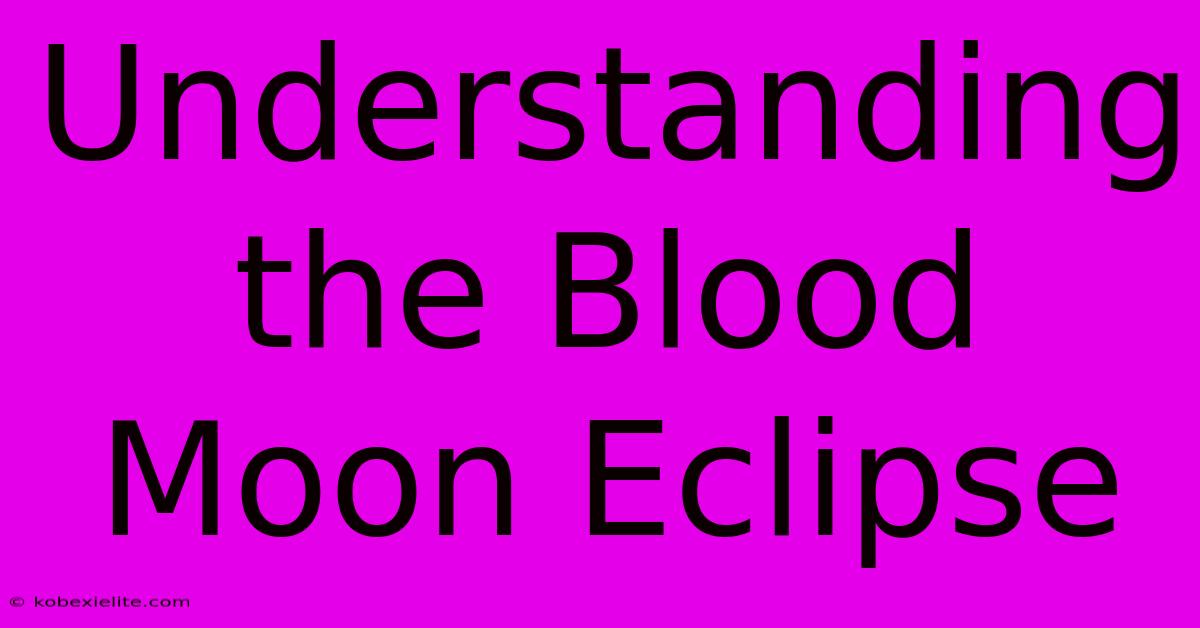Understanding The Blood Moon Eclipse

Discover more detailed and exciting information on our website. Click the link below to start your adventure: Visit Best Website mr.cleine.com. Don't miss out!
Table of Contents
Understanding the Blood Moon Eclipse: A Comprehensive Guide
A Blood Moon eclipse is a captivating celestial event that has fascinated humanity for centuries. This phenomenon, steeped in both scientific understanding and cultural significance, occurs during a total lunar eclipse. But what exactly is a Blood Moon, and what causes this dramatic shift in the moon's appearance? Let's delve into the science and lore behind this breathtaking spectacle.
The Science Behind the Blood Moon
The term "Blood Moon" is a descriptive moniker, not a scientific classification. It refers to the reddish-orange hue the moon takes on during a total lunar eclipse. This striking color isn't caused by some supernatural event, but rather by a fascinating interplay of light and Earth's atmosphere.
Understanding Lunar Eclipses
A lunar eclipse happens when the Earth passes between the Sun and the Moon, casting its shadow on the lunar surface. This only occurs during a full moon. There are three types of lunar eclipses:
- Penumbral Lunar Eclipse: The Moon passes through the Earth's penumbra (outer, fainter shadow). This is often subtle and barely noticeable.
- Partial Lunar Eclipse: A portion of the Moon passes through the Earth's umbra (inner, darker shadow). A part of the Moon appears darker than usual.
- Total Lunar Eclipse: The entire Moon passes through the Earth's umbra. This is when we see the dramatic "Blood Moon" effect.
Why is it Red?
During a total lunar eclipse, sunlight is blocked from directly reaching the Moon. However, some sunlight is bent (refracted) by Earth's atmosphere. This atmospheric refraction scatters away shorter wavelengths of light (like blue and green), while longer wavelengths (like red and orange) are bent towards the Moon. This is the same phenomenon that causes sunrises and sunsets to appear reddish. Therefore, the Moon appears reddish-orange, earning its dramatic nickname. The intensity of the red color can vary depending on atmospheric conditions.
Blood Moon: Cultural Significance and Mythology
Throughout history, Blood Moons have held significant cultural and mythological meaning across various societies. Many cultures viewed these events as ominous signs, portents of disaster, or even the wrath of the gods.
- Ancient Cultures: Ancient civilizations often associated lunar eclipses with battles, deaths, or other significant events. Many cultures developed myths and legends to explain the celestial phenomenon.
- Modern Interpretations: While modern science explains the cause of Blood Moons, the mystique surrounding these events persists. The dramatic appearance continues to capture the imagination and inspire awe.
Observing a Blood Moon Eclipse
Witnessing a Blood Moon eclipse is an unforgettable experience. Here are some tips for optimal viewing:
- Find a Dark Location: Light pollution can significantly impact visibility. Head to a location with minimal light interference for the best view.
- No Special Equipment Needed: Unlike solar eclipses, you don't need any special equipment to safely view a lunar eclipse. Binoculars or a telescope can enhance the viewing experience, but are not essential.
- Check the Timing: Knowing the exact times of the eclipse phases (penumbral, partial, total, etc.) is crucial for planning your viewing. Numerous online resources provide accurate eclipse schedules.
- Share the Experience: Lunar eclipses are best enjoyed with others. Consider gathering friends and family for a shared celestial experience.
Blood Moon Eclipse: Frequently Asked Questions (FAQs)
Q: How often do Blood Moon eclipses occur?
A: Total lunar eclipses, and thus Blood Moons, occur roughly every 1-2 years, although the frequency can vary.
Q: Are Blood Moons dangerous?
A: No, Blood Moons are entirely safe to view with the naked eye. Unlike solar eclipses, there is no risk of eye damage.
Q: Can I photograph a Blood Moon?
A: Yes! A camera with a decent telephoto lens or even a smartphone with good zoom capabilities can capture stunning images of a Blood Moon eclipse.
The Blood Moon eclipse is a truly captivating event, a beautiful blend of scientific wonder and cultural intrigue. Understanding the science behind this celestial spectacle only deepens the appreciation for this magnificent natural phenomenon. So, next time a Blood Moon graces the night sky, take the opportunity to witness and marvel at this awe-inspiring sight.

Thank you for visiting our website wich cover about Understanding The Blood Moon Eclipse. We hope the information provided has been useful to you. Feel free to contact us if you have any questions or need further assistance. See you next time and dont miss to bookmark.
Featured Posts
-
Newcastle Vs Man City Result And Haaland Injury
Feb 17, 2025
-
Bloodhounds Star Kim Sae Ron Dies
Feb 17, 2025
-
Kim Sae Ron Dead Actress Passes Away
Feb 17, 2025
-
Drake Headlines Wireless 2025
Feb 17, 2025
-
Kim Sae Ron South Korean Actress Dead At 24
Feb 17, 2025
